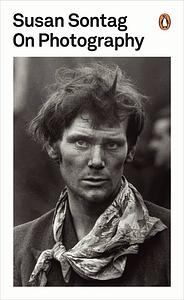You need to sign in or sign up before continuing.
Take a photo of a barcode or cover
challenging
informative
reflective
medium-paced
Сложно как-то оценить эту книгу. Очень много графоманства, язык «для своих». Часто приходилось пробираться через текст. Некоторые предложения перечитывала по 10 раз, давала прочитать другим людям - так и не поняла, что она хотела сказать. Я виню перевод: корявый, косноязычный. Видно, что предложения переводились дословно. Но те конструкции, которые естественно звучат по-английски, по-русски смотрятся странно, что еще больше затрудняет понимание текста. Глаз постоянно цепляется за предложения, весь текст читается с трудом. Сами размышления о фотографии интересны, увлекательны, но каждый раз приходилось заставлять себя брать книгу в руки. Сборник цитат в конце занятный.
informative
reflective
medium-paced
Très très intertextuel. Réflexions nuancées, complexes et profondes sur notre relation à l'image. Extrêmement pertinent encore aujourd'hui.
"Ce qui vide de sens la question de savoir si la photographie est un art ou n'en est pas un, c'est le fait qu'elle annonce (et engendre) de nouvelles ambitions pour les arts. Elle est le prototype de l'orientation caractéristique, à notre époque, de l'art d'avant-garde comme des arts commerciaux: la transformation des arts en méta-arts ou médias. (Le cinéma, la télévision, la vidéo, la musique magnétique de Cage, Stockhausen et Steve Reich sont des prolongements logiques du modèle institué par la photographie.)"
"Ce qui vide de sens la question de savoir si la photographie est un art ou n'en est pas un, c'est le fait qu'elle annonce (et engendre) de nouvelles ambitions pour les arts. Elle est le prototype de l'orientation caractéristique, à notre époque, de l'art d'avant-garde comme des arts commerciaux: la transformation des arts en méta-arts ou médias. (Le cinéma, la télévision, la vidéo, la musique magnétique de Cage, Stockhausen et Steve Reich sont des prolongements logiques du modèle institué par la photographie.)"
challenging
informative
reflective
medium-paced
Graphic: Racism, Xenophobia
challenging
informative
reflective
slow-paced
Sontag makes me feel dumb when talking about philosophy, and nervous when talking about race.
In teaching us a new visual code, photographs alter and enlarge our notions of what is worth looking at and what we have a right to observe. They are a grammar and, even more importantly, an ethics of seeing.
A way of certifying experience, taking photographs is also a way of refusing it—by limiting experience to a search for the photogenic, by converting experience into an image, a souvenir. Travel becomes a strategy for accumulating photographs. The very activity of taking pictures is soothing, and assuages general feelings of disorientation that are likely to be exacerbated by travel. Most tourists feel compelled to put the camera between themselves and whatever is remarkable that they encounter. Unsure of other responses, they take a picture. This gives shape to experience: stop, take a photograph, and move on.
The history of photography could be recapitulated as the struggle between two different imperatives: beautification, which comes from the fine arts, and truth-telling,
Insofar as photography does peel away the dry wrappers of habitual seeing, it creates another habit of seeing: both intense and cool, solicitous and detached; charmed by the insignificant detail, addicted to incongruity. But photographic seeing has to be constantly renewed with new shocks, whether of subject matter or technique, so as to produce the impression of violating ordinary vision.
As Wittgenstein argued for words, that the meaning is the use—so for each photograph. And it is in this way that the presence and proliferation of all photographs contributes to the erosion of the very notion of meaning, to that parceling out of the truth into relative truths which is taken for granted by the modern liberal consciousness.
Out of language, one can make scientific discourse, bureaucratic memoranda, love letters, grocery lists, and Balzac’s Paris. Out of photography, one can make passport pictures, weather photographs, pornographic pictures, X-rays, wedding pictures, and Atget’s Paris.
While the Proustian labors presuppose that reality is distant, photography implies instant access to the real. But the results of this practice of instant access are another way of creating distance. To possess the world in the form of images is, precisely, to reexperience the unreality and remoteness of the real.
Cameras implement an aesthetic view of reality by being a machine-toy that extends to everyone the possibility of making disinterested judgments about importance, interest, beauty. (“That would make a good picture.”)
A capitalist society requires a culture based on images. It needs to furnish vast amounts of entertainment in order to stimulate buying and anesthetize the injuries of class, race, and sex.
Life appears always fully present along the epidermis of his body: vitality ready to be squeezed forth entire in fixing the instant, in recording a brief weary smile, a twitch of the hand, the fugitive pour of sun through clouds. And not a tool, save the camera, is capable of registering such complex ephemeral responses, and expressing the full majesty of the moment. No hand can express it, for the reason that the mind cannot retain the unmutated truth of a moment sufficiently long to permit the slow fingers to notate large masses of related detail. The impressionists tried in vain to achieve the notation. For, consciously or unconsciously, what they were striving to demonstrate with their effects of light was the truth of moments; impressionism has ever sought to fix the wonder of the here, the now. But the momentary effects of lighting escaped them while they were busy analyzing; and their “impression” remains usually a series of impressions superimposed one upon the other. Stieglitz was better guided. He went directly to the instrument made for him. —Paul Rosenfeld
In teaching us a new visual code, photographs alter and enlarge our notions of what is worth looking at and what we have a right to observe. They are a grammar and, even more importantly, an ethics of seeing.
A way of certifying experience, taking photographs is also a way of refusing it—by limiting experience to a search for the photogenic, by converting experience into an image, a souvenir. Travel becomes a strategy for accumulating photographs. The very activity of taking pictures is soothing, and assuages general feelings of disorientation that are likely to be exacerbated by travel. Most tourists feel compelled to put the camera between themselves and whatever is remarkable that they encounter. Unsure of other responses, they take a picture. This gives shape to experience: stop, take a photograph, and move on.
The history of photography could be recapitulated as the struggle between two different imperatives: beautification, which comes from the fine arts, and truth-telling,
Insofar as photography does peel away the dry wrappers of habitual seeing, it creates another habit of seeing: both intense and cool, solicitous and detached; charmed by the insignificant detail, addicted to incongruity. But photographic seeing has to be constantly renewed with new shocks, whether of subject matter or technique, so as to produce the impression of violating ordinary vision.
As Wittgenstein argued for words, that the meaning is the use—so for each photograph. And it is in this way that the presence and proliferation of all photographs contributes to the erosion of the very notion of meaning, to that parceling out of the truth into relative truths which is taken for granted by the modern liberal consciousness.
Out of language, one can make scientific discourse, bureaucratic memoranda, love letters, grocery lists, and Balzac’s Paris. Out of photography, one can make passport pictures, weather photographs, pornographic pictures, X-rays, wedding pictures, and Atget’s Paris.
While the Proustian labors presuppose that reality is distant, photography implies instant access to the real. But the results of this practice of instant access are another way of creating distance. To possess the world in the form of images is, precisely, to reexperience the unreality and remoteness of the real.
Cameras implement an aesthetic view of reality by being a machine-toy that extends to everyone the possibility of making disinterested judgments about importance, interest, beauty. (“That would make a good picture.”)
A capitalist society requires a culture based on images. It needs to furnish vast amounts of entertainment in order to stimulate buying and anesthetize the injuries of class, race, and sex.
Life appears always fully present along the epidermis of his body: vitality ready to be squeezed forth entire in fixing the instant, in recording a brief weary smile, a twitch of the hand, the fugitive pour of sun through clouds. And not a tool, save the camera, is capable of registering such complex ephemeral responses, and expressing the full majesty of the moment. No hand can express it, for the reason that the mind cannot retain the unmutated truth of a moment sufficiently long to permit the slow fingers to notate large masses of related detail. The impressionists tried in vain to achieve the notation. For, consciously or unconsciously, what they were striving to demonstrate with their effects of light was the truth of moments; impressionism has ever sought to fix the wonder of the here, the now. But the momentary effects of lighting escaped them while they were busy analyzing; and their “impression” remains usually a series of impressions superimposed one upon the other. Stieglitz was better guided. He went directly to the instrument made for him. —Paul Rosenfeld
challenging
inspiring
reflective
informative
reflective
slow-paced
challenging
informative
reflective
fast-paced







